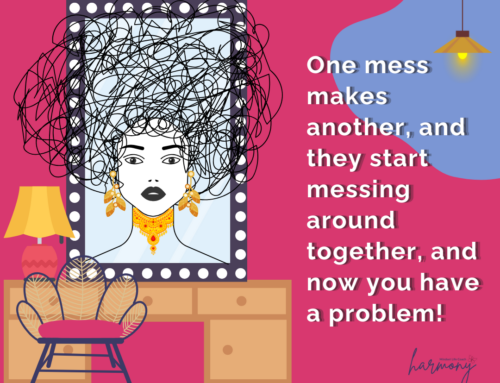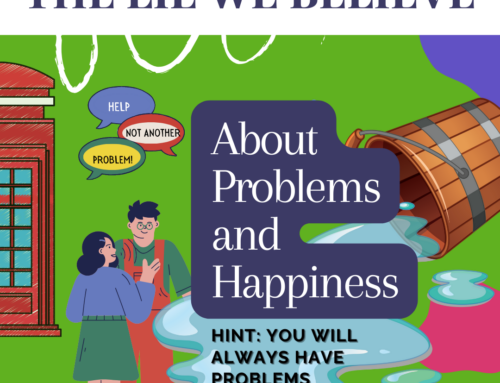Imagine waking up to find your health insurance canceled. Your stomach tightens, and panic creeps in—how will you afford medical care?
Immediately, your brain jumps to solutions: Maybe I can find a loophole to keep it? Maybe I should take a second job to afford private insurance. I may need to move somewhere cheaper. The mind races, grasping at whatever feels like a fix.
Your reactive thoughts aren’t solutions to the real problem.
Never try to solve all the problems at one. Make them line up for you one by one. Richard Sloma
Why We Misdiagnose Problems
Daniel Kahneman’s work in Thinking, Fast and Slow explains that our brains love quick conclusions. When stress hits, the brain defaults to fast thinking—jumping straight to action before fully defining the problem. We latch onto symptoms rather than identifying the root cause because it feels like progress.
But if you only treat symptoms, the real issue remains—causing frustration, exhaustion, and a cycle of temporary fixes that don’t solve anything.
Neuroscientist Dr. Lisa Feldman Barrett adds that emotions heavily influence problem perception. When fear takes over, the brain narrows its focus, making it harder to step back and analyze what’s really going on. Instead, we catastrophize and rush into solutions that might not be necessary—or effective.
How to Recognize if You Trying to Solve the Wrong Problem
When faced with a problem, our brain craves certainty. It wants an answer now—even if that answer is wrong. The misguided culprits typically include cognitive biases, emotional triggers, and faulty assumptions, which sabotage clear thinking.
So, how do you know if you’re jumping to inaccurate conclusions?
1. You’re Stuck in an Emotional Loop
🔹 When strong emotions like fear, frustration, or anger dominate, they hijack rational thinking. Neuroscientist Dr. Lisa Feldman Barrett explains that our brain creates emotions based on past experiences. If something feels threatening, our mind assumes it is—even if that’s not true.
🔹 Check yourself: Are you panicking because of actual data or because your brain automatically fills in worst-case scenarios?
2. You Accept the First Explanation That Comes to Mind
🔹 Daniel Kahneman’s Thinking, Fast and Slow describes how our brain defaults to “fast thinking”—quick, instinctive reactions based on past patterns. But the first answer isn’t always the right one.
🔹 Check yourself: Did you consider multiple explanations before settling on one? Or did you grab the first conclusion that felt familiar?
3. You’re Solving a Problem That Feels Urgent—But Might Not Be the Real Issue
🔹 Urgency creates tunnel vision. If your brain sees a crisis, it narrows focus to fix it ASAP, often missing the deeper problem.
🔹 Check yourself: Are you treating the symptom instead of the root cause? What happens if you zoom out and reframe the problem?
4. Your conclusion is based on personal belief—rather than evidence (and social media is making it worse).
🔹 If you “believe “I’ll never find another job,” your brain automatically filters reality to support that belief. Known as confirmation bias, we seek information that reinforces what we already think, even if it’s wrong.
But now, social media takes this bias and supercharges it.
How Social Media Shapes (and Warps) Your Reality
Social media algorithms track what we engage with—what we click, “like,” and what media we turn on for just a few extra seconds. Over time, they feed us more of the same, reinforcing a narrowed version of reality.
- If you engage with content about how the economy is collapsing, you’ll see more of it—whether or not it’s true.
- If you read posts about dead job markets, your feed will make it seem like no one is hiring. WRONG.
- If you click on negative news, you’ll become convinced by that “evidence” that things are only getting worse.
Face it, you are trapped in a feedback loop of misinformation.
Solving the Right Problem: How to Find the Root Cause and Fix It for Good
When we face challenges, our first instinct is often to react quickly—find a fix, patch the problem, and move on. But too often, we solve symptoms instead of root causes, leading to temporary relief instead of lasting change.
So, how do we get to the real issue? Let’s examine three case studies.
Case Study #1: “I Lost My Health Insurance”
🔹 Symptom Thinking: I need health insurance right now. I should call every provider, look for emergency plans, or take a job I hate just for the benefits.
🔹 Root Thinking: Why do I feel panicked? → Because I fear unexpected medical costs. → Why? → Because I believe I have no alternative options for healthcare. → Why? → Because I’ve never explored other safety nets or negotiated medical costs.
Shifting the Focus:
Instead of seeing the problem as “I don’t have insurance,” the real issue is ensuring access to medical care in an uncertain system, which opens up more creative solutions:
✅ Exploring community health clinics or direct-pay models
✅ Learning medical negotiation strategies to lower costs
✅ Researching non-traditional health plans, like health-sharing networks
✅ Checking eligibility for state programs that may offer assistance
The fear doesn’t vanish, but now you’re solving the problem of securing medical care—rather than scrambling for an insurance plan that may not be the only answer.
Case Study #2: “I Only Have One Month of Savings, and No One’s Hiring”
🔹 Symptom Thinking: I need a job. Any job. Now.
🔹 Root Thinking: Why am I panicked? → Because I don’t feel financially secure. → Why? → Because I assume a traditional job is the only way to survive. → Why? → Because I’ve never explored alternative income sources beyond employment.
Shifting the Focus:
The real issue isn’t unemployment—it’s financial insecurity. Reframed this way, solutions widen:
✅ Taking on freelance or gig work to fill the gap
✅ Selling unused assets or monetizing existing skills
✅ Starting a temporary side hustle to extend savings
✅ Cutting non-essential expenses without sacrificing mental health
The real goal isn’t just getting hired—it’s finding ways to generate income. Once you see that, new opportunities emerge that weren’t visible before.
Case Study #3: “My Elderly Mother Needs Care, But I Can’t Afford Help”
🔹 Symptom Thinking: I must quit my job, take out loans, or beg relatives for help.
🔹 Root Thinking: Why do I feel trapped? → Because I believe I’m alone in solving this. → Why? → Because I haven’t mapped out all available resources or explored creative solutions.
Shifting the Focus:
Instead of seeing this as an either/or situation (work vs. caregiving), reframing it as a support system problem leads to new possibilities:
✅ Researching local senior services for low-cost daytime care
✅ Asking community groups for volunteer respite support
✅ Exploring remote work or job-sharing options for more flexibility
✅ Looking into state-funded home assistance programs
Many people burn out because they assume the only answer is to do it alone. However, new opportunities open when we redefine the problem as finding sustainable support.
Learn to Recognize the Pattern of Symptoms or Solutions
🔹 Symptoms are what we see.
🔹 Root causes are what drive the problem.
🔹 Solving symptoms = temporary relief.
🔹 Solving root causes = permanent change.
When you find yourself stuck in panic mode, pause and ask:
Am I reacting to a symptom or solving the real issue?
The deeper you dig, the more power you reclaim over your life.
Final Thought: What Einstein Knew About Problem-Solving
Einstein famously said,
“If I had an hour to solve a problem, I’d spend 55 minutes thinking about the problem and 5 minutes thinking about solutions.”
If we rush to fix what we think is the problem, we waste time-solving the wrong thing. But if we take the time to define the real issue, solutions become clearer, smarter, and far more effective.
So, next time you face a crisis, ask yourself:
Should I continue cursing the car key or check the car battery?
The limitations we believe become the reality we experience. We can change that!





